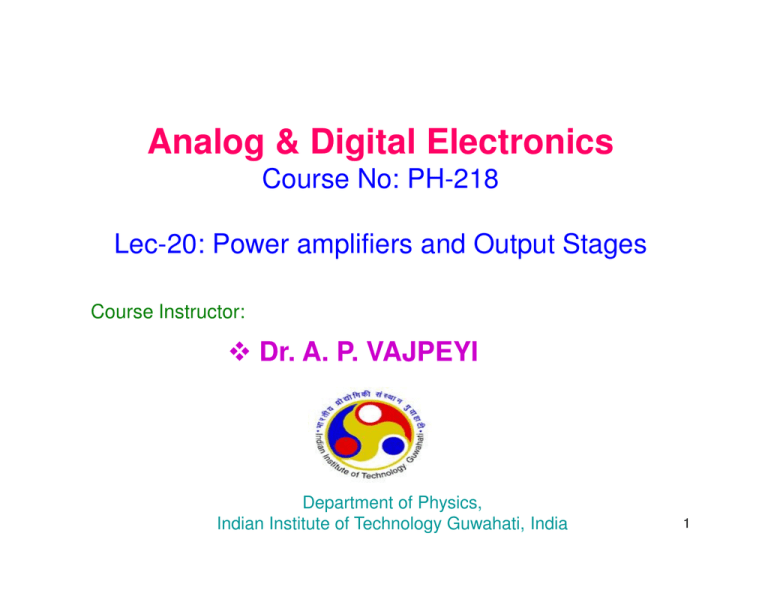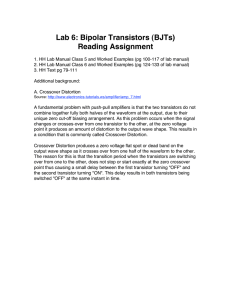Lecture-20 - IIT Guwahati
advertisement

Analog & Digital Electronics Course No: PH-218 Lec-20: Power amplifiers and Output Stages Course Instructor: Dr. A. P. VAJPEYI Department of Physics, Indian Institute of Technology Guwahati, India 1 Class B Power amplifier If the collector current flows during the half cycle of the signal only, the power amplifier is known as class B amplifier. To have this kind of operation, Q point must be located at cut-off. At cut-off point ICQ = 0 and VCEQ = VCE-off Transistor cut off if: vI < 0.7V The advantage of a class-B amplifier is that the collector current is zero when the input signal to the amplifier is zero. Therefore the transistor dissipate no power in the quiescent condition. 2 Class B Push-Pull amplifier A 2nd class B BJT is needed to conduct for the negative vI cycle. complementary-symmetry amplifier Class B Crossover Distortion Complementary transistors means one of the transistors is a npn and the other is pnp. Need dual-polarity power supplies. Crossover distortion in audio power amps produces unpleasant sounds. 3 Efficiency: Push Pull Class B Power amplifier Pi ( dc) = VCC I DC = Vce = Vce− p VCC I C V = CC 2 2 2 Po (ac) = Vce × I ce π I ce = Po (ac) η= ×100% Pi (dc) I ce− p 2 = IC 2 Vce × Ice η= ×100% = 0.25π % = 78.5% VCC × ICQ 4 Class B Crossover Distortion Crossover distortion in audio power amplifers produces unpleasant sounds. To prevent crossover distortion, both transistors will normally be biased at a level that is slightly above cutoff. 5 Class AB power amplifier To eliminate crossover distortion, both transistors in the push-pull arrangement must be biased slightly above cut-off when there is no signal. Voltage Divider bias Diode biasing circuit In voltage divider bias circuit difficult to maintain a stable bias point due to changes in VBE over temperature changes. (i.e. ∆temp → ∆Q-point ) When the diode characteristics of D1 and D2 are closely matched to the transconductance characteristics of the transistors, a stable bias can be maintained over temperature. Amplifier Distortion If the output of an amplifier is not a complete AC sine wave, then it is distorting the output. The amplifier is non-linear. This distortion can be analyzed using Fourier analysis. In Fourier analysis, any distorted periodic waveform can be broken down into frequency components. These components are harmonics of the fundamental frequency. Harmonics are integer multiples of a fundamental frequency. If the fundamental frequency is F kHz: 1st harmonic 1 x F kHz 2nd harmonic 2 x F kHz 3rd harmonic 3 x F kHz 4th harmonic 4 x F kHz Note that the 1st and 3rd harmonics are called odd harmonics and the 2nd and 4th are called even harmonics. 7 Harmonic Distortion Calculations Harmonic distortion (D) can be calculated: Where A1 is the amplitude of the fundamental frequency An is the amplitude of the highest harmonic. The total harmonic distortion (THD) is determined by: 8 Power Transistor Heat Sinking Power transistor can dissipate many watts. All power devices are packaged in cases that permit contact between a metal surface and an external heat sink. In most cases that metal surface of device is electrically connected to one terminal (e.g. for power transistors the case is always connected to the collector). heat sink :- provides additional surface area to conduct heat away from the transistors more quickly to prevent overheating. The whole point of heat sinking is to keep the transistor junction below some maximum specified operating temperature. For Si transistors in metal packages the maximum junction temperature is usually 2000C, whereas for transistors in plastic packages it is usually 1500C. 9 Power Transistor derating curve PD (T1 ) = PD (T0 ) − κ (T1 − T0 ) Where PD(T0) = Max dissipated power at T0 PD(T1) = Max dissipated power at T1 T0 = temp at which derating starts T1 = Temp of interest = derating factor (W /oC) κ Power Transistor Thermal analogy T j ,max − Tamb θ = θ jc + θcs + θ sa Ptotal = θ Ptotal = total dissipated power in the transistor ; Tj-max = Max junction temperature ; Tamb = ambient temp ; Θ = total thermal resistance θ jc = junction to case thermal resistance ; θcs = case to heat sink thermal resist θ sa = sink to ambient thermal resistance 10 Class C power amplifier Class C amplifiers are used extensively in radio communications circuits. A class C amplifier conducts for less than 180°. The transistor is biased with a negative VBE Thus it will conduct only when the input signal is above a specified positive value. i.e. transistor ‘ON’ when Vin > VBB + VBE The power dissipation of the transistor in a class-C amplifier is low because it is on 11 for only a small percentage of the input cycle. Class D power amplifier A class D amplifier amplifies pulses, and requires a pulsed input. There are many circuits that can convert a sinusoidal waveform to a pulse, as well as circuits that convert a pulse to a sine wave. This circuit has applications in digital circuitry. 12 Operating point on load line for various output stages Ic Class A Class AB Class B Vce Class C http://books.google.co.in/books?id=mrs1IwRTzo0C&pg=PR12&lpg=PR12&dq=frequency+response+of+multistage+ amplifiers&source=bl&ots=7vQ4XNKqom&sig=wsE3NpE8kja8FrqpKindgL_caNY&hl=en#v=onepage&q=frequency %20response%20of%20multistage%20amplifiers&f=false 13

